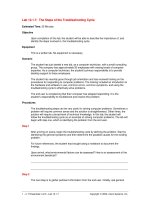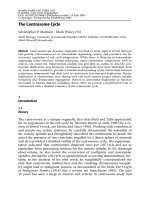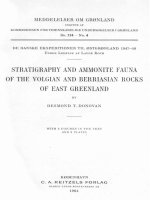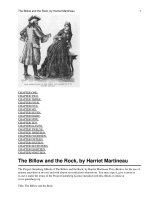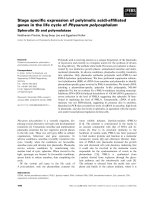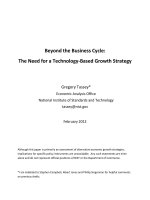The rock cycle metamorphic rocks
Bạn đang xem bản rút gọn của tài liệu. Xem và tải ngay bản đầy đủ của tài liệu tại đây (2.08 MB, 26 trang )
EARTH MATERIALS VIII
The Rock Cycle: Metamorphic Rocks
Professor Peter Doyle
THE ROCK CYCLE
Metamorphic rocks: typically complex
Pressure indicated by fabric (foliation)
Heat indicated by growth of new
minerals/crystals
Metamorphic Rocks
Two major types of metamorphism
• Regional metamorphism occurs when
large areas of the crust are subjected to
high temperatures and/or pressures
• Contact metamorphism occurs adjacent
to igneous intrusions causing mainly an
increase in temperature but also pressure
in some instances
METAMORPHIC FACIES: temperature & pressure regimes
Low Pressure
High Pressure
Low temperature
High Temperature
Assemblage of metamorphic rocks formed under a similar range
of pressure and temperature conditions
METAMORPHIC FACIES: typical settings
Intraplate: normal range
Contact: High
temperature
Arc: increased
temperature
Subduction zones: high pressure
Increasing Temperature
METAMORPHIC FACIES: mineral assemblages
Original chemistry of parent rock controls the mineral
assemblage formed during metamorphism
Metamorphic Index minerals
• INDEX MINERALS are diagnostic minerals formed by
metamorphic reactions
• They are a function of P, T and rock & fluid
compositions (X) at time of the reaction
• Used to define metamorphic zones
• Demonstrates progress of metamorphism
REGIONAL METAMORPHISM OF SHALES
LOW GRADE
HIGH GRADE
CHLORITE
BIOTITE
GARNET
STAUROLITE
KYANITE
SILLIMANITE
Index Minerals
formed: controlled
by original rock
(X), P, and T.
ISOGRADS: lines on a geological map showing locations
of first appearance of index minerals
Increasing grade
Record of sets of P-T-X conditions in the metamorphic
reaction
Minerals function of temperature, pressure & parent rock
Increasing Grade & relevant facies
Index
minerals
REGIONAL METAMORPHISM OF SHALES
Increasing Grade & relevant facies
Index
minerals
REGIONAL METAMORPHISM OF BASALTS
CONTACT METAMORPHISM: heat alone
SANDSTONES & SHALES:
(siliciclastic source)
LIMESTONES: (carbonate source)
Minerals produced a function of temperature & parent rock
TEXTURES: INDICATORS OF METAMORPHIC
PROCESS
Pressurized
Heated
Foliated rocks: pressurised rocks
• Pressure induces re-organisation and growth of
new minerals
• Large percentages of platey minerals
• Increasing grade indicated by level of foliation:
Slate-Phyllite-Schist-Gneiss
• Slate: splitting surfaces at an angle to bedding
• Phyllite:
Phyllite similar, with platy mineral growth
• Schist: segregation of platey minerals in preferred
orientation
• Gneiss: Coarser grade foliation, distinct banding
FOLIATED ROCKS
phyllite
FOLIATION: INTENSITY INCREASES WITH INCREASING
PRESSURE
DEVELOPMENT OF FOLIATION
Platy minerals oriented normal to compressive forces
Compressive
stress
GRAIN
ORIENTATION
Schist
SLATEY CLEAVAGE: planar foliation (not bedding)
Little new mineral growth
SCHISTOSITY: wavy foliation
Porphyroblasts:
new crystal
growth in matrix
SCHIST WITH GARNET PORPHYROBLASTS
GLAUCOPHANE BLUE SCHIST
High Pressure metamorphism
GNEISSOSE FOLIATION, SEGREGATION OF
MINERALS (micas, feldspar, quartz, amphibole,
etc)
Non-foliated metamorphic rocks I:
Contact metamorphism
• Formed from contact heating or regional
metamorphism
• Hornfels: formed by high temperature/low
pressure contact metamorphism, uniform
grain size with no preferred orientation
• FINE GRAINED GRANULAR (GRANOBLASTIC)
• Spotted Hornfels: similar, but with small
irregular porphyroblasts of minerals such as
cordierite & andalusite
• Minerals form during metamorphic heating
at low pressures
Contact metamorphic rocks
Spotted hornfels:
porphyroblasts
Hornfels: uniformly granular
Non-foliated metamorphic rocks II:
Regional metamorphism
• Quartzites: metamorphosed quartzrich sandstones
• metamorphism produces recrystallised,
recrystallised
uniform-sized,
uniform-sized quartz crystals with no
foliation
• Marbles: metamorphosed limestones
• metamorphism produces uniform,
uniform
equigranular,
equigranular interlocking recrystallised
calcite crystals with no foliation.
